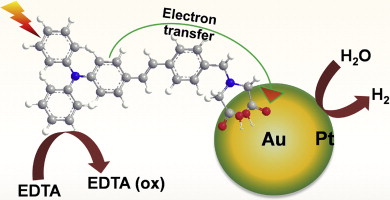Manhuan Chenga, b, Mingshan Zhuc, Yukou Dua, Ping Yanga* (杨平)
a College of Chemistry, Chemical Engineering and Materials Science, Soochow University, Suzhou 215123, China
b Modern Educational Technology Center, Huangshan University, Huangshan 245041, China
c CAS Key Laboratory of Colloid, Interface and Chemical Thermodynamics, Institute of Chemistry, Chinese Academy of Sciences, Beijing 100190, China
Int. J. Hydrogen Energy 2013, 38, 8631–8638.
An efficient photocatalytic hydrogen evolution system based on triphenylamine-based dye functionalized bimetallic Au@Pt core/shell nanocomposite (Au@Pt-TPAD) was reported. Transmission electron microscopy (TEM), X-ray diffraction (XRD) and UV–vis absorption spectra suggested that Au@Pt-TPAD nanocomposite consisted of a bimetallic nanoparticle with Au core and Pt shell nanostructure. The photoelectrochemical result suggested that photoinduced electrons could efficiently transfer from the triphenylamine derivative molecules to the bimetallic nanoparticles. Photocatalytic results showed that the Au@Pt2-TPAD bimetallic nanocomposite could be used as a stable photoinduced H2 evolution photocatalyst. Compared with the monometallic counterpart (Au-TPAD or Pt-TPAD), the bimetallic nanocomposite showed much higher catalytic activity for the photocatalytic hydrogen evolution. The amount of hydrogen evolution on the optimal catalyst under 12 h UV–vis light irradiation was about 37.5 μmol. The enhancement of the photocatalytic activity might be attributed to the synergistic effect between the two metals in bimetallic nanoparticles with core/shell structure. This investigation might open up new opportunities for the development of dye functionalized heterometallic nanocomposite with enhanced photocatalytic performance.

链接: //www.sciencedirect.com/science/article/pii/S0360319913012020